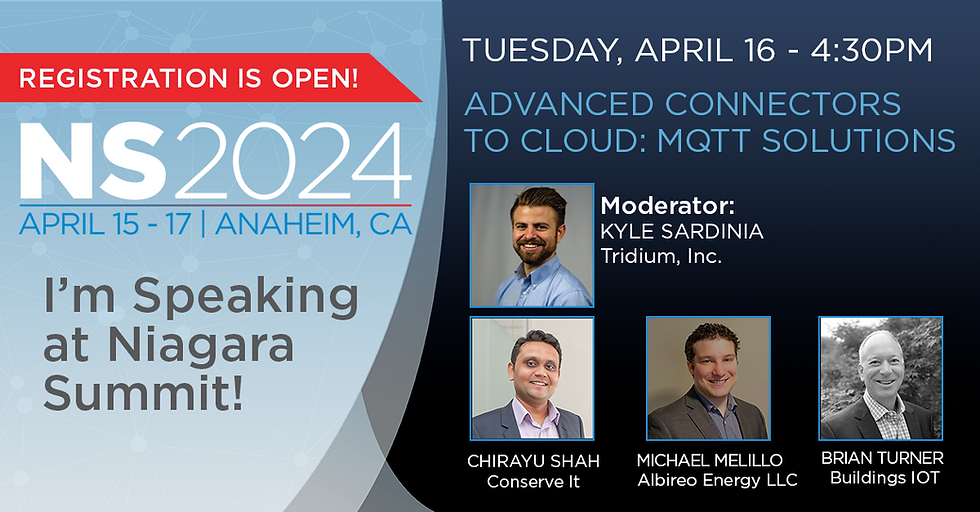Project Haystack Selected Among Department of Energy's BENEFIT Funding Opportunity
- Conserve It

- Oct 18, 2021
- 3 min read
The Project Haystack Organization, a collaborative community addressing the challenge of utilizing semantic modeling and tagging to streamline the interchange of data among different systems, devices, equipment and software applications, today announced they are among the U.S. Department of Energy (DOE) Building Technologies Office (BTO) projects selected from its Buildings Energy Efficiency Frontiers & Innovation Technologies (BENEFIT) funding opportunity announcement.

Earlier, the DOE announced nearly $83 million in funding to 44 projects that will lower Americans' energy bills and help meet President Biden's goal of net-zero carbon emissions by 2050 by investing in new energy efficient building technologies, construction practices, and the U.S. buildings-sector workforce. 23 projects were selected under Topic Area 1: Building Technology Research, Development, and Field Validation. Project Haystack is one of two projects selected under "Energy and Demand Data, Modeling, and Analytics".
The objective of the project is for Project Haystack to create a validation and accreditation framework for semantic metadata templates and models with associated open-source tools and deploy an accreditation system for semantic interoperability. It is expected this will lower costs, reduce installation time, improve delivered quality, and remove knowledge barriers for service implementers.
The project work plan is divided into three major technical scopes, each aligned with a budget period. The goal of the project will result in an extended ontology and suite of software tools which can be used to automatically validate semantic models of commercial facilities. This technology can then serve as the foundation for a marketing program to educate building owners on the value of specifying semantic models in their projects.
"We are grateful for the DOE's commitment and investment in our energy efforts," said John Petze, Executive Director of the Project Haystack Organization. "These validation tools will be used for accreditation, ensuring building owners that their system integrator is leaving them with a high-quality model of their facility. These ready-to-use semantic models will allow for more cost-effective operations and higher energy savings. Ultimately, this would likely serve as a catalyst for vendors to add semantic modeling into their products creating a positive feedback loop."
Currently, residential and commercial buildings account for more than one-third of the climate-altering carbon pollution America releases each year, and consume 40% of the nation's energy, and 75% of its electricity. Pursuing energy efficiency innovations is one of the most cost-effective means to keep the growth of energy consumption from spiraling upwards as society's energy needs grow.
The 44 projects across 20 states will improve building energy efficiency through innovations in thermal energy storage, building envelopes, lighting, heating, ventilation, air conditioning, refrigeration, and water heating – as well as by bolstering America's energy efficiency workforce with trainings, educational programs, and other technical support.
The Project Haystack Organization consists of Founding Member and Board Member companies Conserve It, J2 Innovations, Legrand, Lynxspring, Siemens and SkyFoundry, and Associate Member companies 75F, Accu-Temp Systems, Allander Analytics, Altura Associates, Automated Logic, BASSG, Brainbox AI, Bueno Systems, BuildingFit, Buildings IOT, Clockworks Analytics, CABA, e-Magic, Energy Management Association, Intellastar, Intelligent Buildings, IoT Warez, KMC Controls, KNX Association, Switch Automation, Tridium, WideSky and Yorkland Controls, as well as numerous Haystack supporters involved in the Project Haystack Forums and Working Groups.
For more information about the DOE's work to improve buildings, visit https://www.energy.gov/eere/buildings/building-technologies-office.
About Project Haystack
Celebrating 10 Years! Since its formation in March of 2011, the Project Haystack Organization, a 501(c) non-profit trade association, has been providing the industry with an open-source, collaborative environment to address the challenge of making data self-describing using semantic modeling, also known as data tagging. The work developed by the Project Haystack member companies and community streamlines the process of managing, presenting and analyzing the vast amount of data produced by smart devices and equipment systems. The Haystack methodology can be used with virtually any type of system and device data and is not tied to any vendor or communication protocol.
About Conserve It
Conserve It is an international leader in Smart IoT Solutions, building automation and HVAC solutions, having designed the award-winning plant room optimisation solution PlantPRO and is a founding member of Project Haystack.
Headquartered in Melbourne, Australia, the Conserve It team has a wealth of knowledge and vast experience in control and optimisation solutions that ensure central plant equipment runs efficiently, minimises energy consumption and maximises cost saving opportunities.



Comentarios